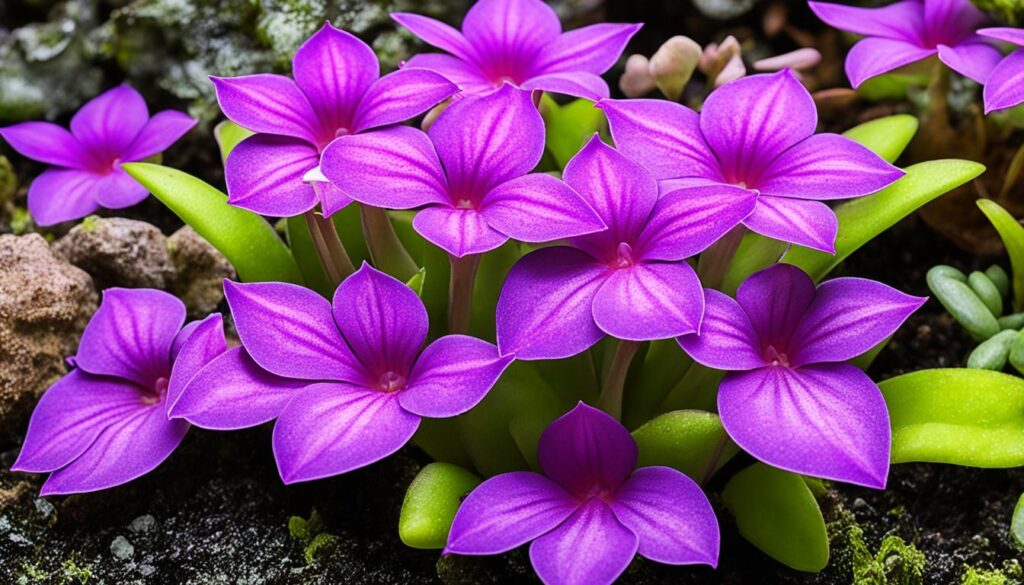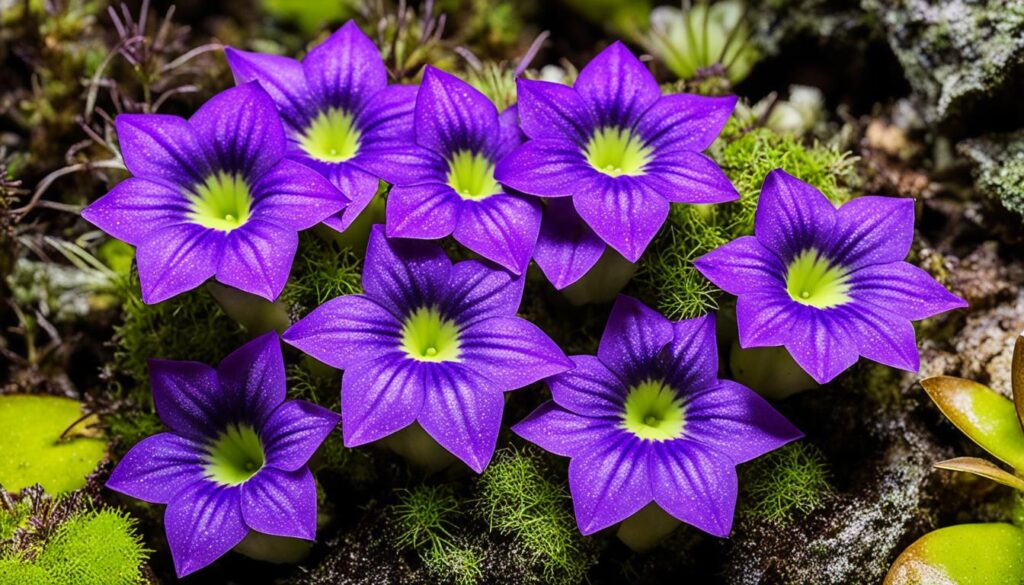Ever heard of Pinguicula grandiflora? It’s also called the large-flowered butterwort. This plant is loved for its beautiful flowers. Want to learn more about this amazing wildflower? Let’s explore what makes it special and how to grow it.
Introduction to Pinguicula grandiflora
Pinguicula grandiflora is a part of the Lentibulariaceae family and comes from Europe. It is a special carnivorous plant that catches insects. It stands out thanks to its big flowers among other butterworts. Let’s learn more about this captivating plant.
What is Pinguicula grandiflora?
The large-flowered butterwort is its common name. It is a perennial plant which means it comes back every year. It eats small insects and grows in cool, mountain areas. This plant has cool tricks that help it catch bugs for food.
Native Range and Habitat
It’s found in many European countries like France, Ireland, and Spain. It needs cool nights to survive, so it’s rare outside its natural areas.
In Ireland’s Burren area, a special type of Pinguicula grandiflora was discovered. It’s not very common and grows in hard-to-reach places high up in the mountains.

In order to grow it outside its home, people carefully collect small parts of the plant. Then they grow these parts, but they make sure not to hurt the original plant. This helps keep the plant from becoming too rare or endangered.
Botanical Classification and Nomenclature
Pinguicula grandiflora is the name for the large-flowered butterwort. It belongs to the Kingdom Plantae. It also falls under more specific groups like Clade Tracheophytes and Clade Angiosperms.
Its full name is Pinguicula grandiflora Lam. Other names for it include Pinguicula vulgaris subsp. grandiflora (Lam.) Magnin. And, Pinguicula vulgaris f. grandiflora (Lam.) St.-Lag., Pinguicula vulgaris var. grandiflora (Lam.) Fr..
The plant has had a lot of attention from researchers. They have looked at its plant structure, genetics, and naming. This work has helped us learn a lot about this carnivorous plant.

This butterwort plant is mostly found in Central to East Spain. It grows on tall, rocky cliffs. Its roots attach to the rocks. These plants are also grown by people. They use seeds from places like the Hoz de Beteta and the Rio Guadiela.
Pinguicula grandiflora: Key Features
Pinguicula grandiflora, also known as the large-flowered butterwort, is a thrilling carnivorous plant. It stands out with its large flowers and carnivorous nature. These features make it unique and attractive to many.
Distinctive Large Flowers
Among its many features, Pinguicula grandiflora delights with its large, showy flowers. They can be several inches wide, much bigger than most in its family. These flowers are a deep, violet-blue, contrasting beautifully with the plant’s green leaves.
The big flowers serve a special function. They attract a variety of insect pollinators. These insects help the plant reproduce. They carry pollen, leading to the creation of seed capsules.
Carnivorous Nature and Prey
Besides its stunning flowers, Pinguicula grandiflora has a carnivorous nature. It feeds on small insect prey, supplementing its diet from the soil. The plant does this through its sticky leaves.
When an insect touches the leaf, it gets stuck. The plant then digests the insect with its enzymes, absorbing the nutrients. This process benefits the plant’s growth.
This carnivorous diet helps Pinguicula grandiflora survive in poor soil areas. It gets the necessary nutrients by eating small insects.
Growth Cycle and Dormancy
Pinguicula grandiflora, or the large-flowered butterwort, has a unique growth cycle that follows the seasons. It starts to wake up as spring comes. This carnivorous plant shows off its beautiful flowers then.
Spring Emergence and Blooming
At the start of spring, Pinguicula grandiflora comes out of its winter sleep. It grows its wide, sticky leaves into a rosette shape, clearly showing how it eats. Next, it shows off its big, 2-inch flowers that come in purple or white. These flowers help the plant reproduce.
Summer Foliage Growth
When summer comes, Pinguicula grandiflora focuses on growing its leaves. Its rosette gets bigger and greener. These leaves are sticky because they trap and eat tiny insects, helping the plant get more nutrients.
Autumnal Dormancy Preparation
By autumn, Pinguicula grandiflora is getting ready to sleep. It drops its leaves to save energy and hides under the ground. It creates special buds, hibernacula, to protect itself from the cold until spring.
| Season | Growth Phase | Key Characteristics |
|---|---|---|
| Spring | Emergence and Blooming |
|
| Summer | Foliage Growth |
|
| Autumn | Dormancy Preparation |
|
Cultivating Pinguicula grandiflora
Growing the large-flowered butterwort, Pinguicula grandiflora, has its challenges. Yet, with the proper settings, this mesmerizing carnivorous plant can grow well. Let’s look into what it needs to flourish.
Soil and Water Requirements
Pinguicula grandiflora does best in a mix that drains well. Use a mix of 1 part peat moss and 3 parts perlite. This mix balances holding moisture and letting air reach the roots. It’s vital to water it with low-mineral water. The water should have 50 parts per million or less of dissolved minerals to keep the plant healthy.
Light and Temperature Needs
This plant loves light but not direct sun. It prefers light that’s filtered, or dappled, through something like a light curtain or a tree. Because it’s from cooler regions, this plant also needs cool nights. The temperature should go down to the 60s Fahrenheit (around 15-20°C). This keeps the plant from getting too tired and weak.
It’s vital to get the cultivation, soil, water, light, and temperature just right. Perfecting these conditions leads to strong Pinguicula grandiflora plants. With dedication and the correct approach, this unique carnivorous plant can turn into a special part of any plant lover’s collection.
Pinguicula grandiflora Subspecies
The Pinguicula grandiflora has two subspecies: Pinguicula grandiflora subsp. grandiflora and Pinguicula grandiflora subsp. rosea. They vary slightly in things like flower color. But, all share the same big and beautiful flowers.
Pinguicula grandiflora subsp. rosea stands out with its light pink flowers. This is different from the typical purple flowers of the grandiflora species. It’s found in many European countries, like Spain, France, and Italy.
Sometimes, a plant with white flowers appears. This form is called Pinguicula grandiflora f. chionopetra. It’s seen in places like the Burren of Ireland and the French Pyrenees. Along with the white type, these variations make the plant even more interesting.
| Pinguicula grandiflora Subspecies | Distinguishing Features | Native Range |
|---|---|---|
| Pinguicula grandiflora subsp. grandiflora | Typical deep purple flowers | Western Europe, including Spain, France, Switzerland, Ireland, and Northern Italy |
| Pinguicula grandiflora subsp. rosea | Light pink flowers | Spain, France, Switzerland, Austria, Italy, and other parts of Europe |
| Pinguicula grandiflora f. chionopetra | Rare white-flowered form | Burren region of County Clare, Ireland, and the French Pyrenees |
There are about 100 different species in the Pinguicula genus. They are found in Europe, Asia, and the Americas. The Pinguicula grandiflora subspecies are especially known for their big beautiful flowers. This makes them loved by people who like to grow carnivorous plants.
Conservation Status and Threats
The large-flowered butterwort, Pinguicula grandiflora, is rare and under threat in some places. Its survival is challenged by specific needs and a small area where it naturally grows. This carnivorous plant is at risk due to losing its habitat, climate change, and being taken for gardening.
The International Union for Conservation of Nature (IUCN) marks Pinguicula grandiflora as Endangered. In Switzerland, it’s a priority to protect, with efforts shared internationally for its conservation.
It’s worth noting that this plant is Endangered on both the National and Regional Red Lists in Switzerland. This means its survival is at serious risk.
Currently, Pinguicula grandiflora doesn’t have enough protection, locally or globally. The main dangers for it are:
- Collecting and photography, which can harm the area and plant by walking over it
- Tourism impact, needing careful handling and limited access by visitors
- Forestry activities, for example, influencing the places where the plant grows
To fight these threats, several steps have been taken:
- Establishing plant protection zones
- Erecting informational signage
- Implementing visitor management strategies
- Protecting known populations and their habitats
- Conducting regular population assessments
The goal is to protect what’s left of Pinguicula grandiflora and help it thrive. Yet, constant care and conservation work are needed for it to survive for the long term.
Historical and Cultural Significance
Pinguicula grandiflora, or the large-flowered butterwort, is important in history and culture. It comes from Europe and is a carnivorous plant. Because of its look and special abilities, it has long interested botanists, naturalists, and gardeners.
The historical significance of P. grandiflora includes its use in herbal medicine. In Europe, people once thought it could heal, aiding with skin and stomach issues. This use over time has kept the plant significant.
P. grandiflora is also a part of many folktales and legends. Some ancient stories gave it supernatural powers because it eats insects. These tales add to its cultural meaning in its native lands.
Cultural significance includes its role in botany and planting. Scientists study its ways of catching bugs, helping us understand more about these plants. Its beauty also makes it a favorite for those who love gardens.
In summary, Pinguicula grandiflora is key in history, stories, and science. This plant still captures the hearts and minds of many worldwide, showing us the wonders of the natural world.
Pinguicula grandiflora in Cultivation
Cultivating the large-flowered butterwort, Pinguicula grandiflora, has some challenges. It needs cool nights, low-mineral water, and soil that drains well. Despite these needs, many have found ways to grow and care for it successfully.
Challenges and Tips
Growing P. grandiflora means creating the right environment for it. It loves cool temperatures. Nights should be around 50°F (10°C) and days shouldn’t go over 75°F (24°C). This can be tough in warm areas. The plant also needs special water to avoid harm from minerals in the soil.
The plant’s soil mix must drain well. Mix peat moss, sand, and perlite or vermiculite. Good drainage helps avoid root rot. In the fall, a short rest helps the plant get ready for the next growing season.
- Maintain cool temperatures, with nighttime lows around 50°F (10°C) and daytime highs not exceeding 75°F (24°C)
- Use low-mineral, distilled, or reverse osmosis water to prevent mineral buildup in the soil
- Provide a well-draining soil mix, such as a combination of peat moss, sand, and perlite or vermiculite
- Implement a dormancy period in the autumn to allow the plant to prepare for the next growing season
Overcoming these challenges is possible. It takes careful attention and the right techniques. With these, you can see the plant’s beautiful, big flowers. Plus, you help protect this special plant.
Related Pinguicula Species
Pinguicula grandiflora stands out as a unique plant in the *Pinguicula* family. Yet, it has company. Species like Pinguicula vulgaris, Pinguicula lusitanica, and Pinguicula alpina are similar. They all eat insects and have certain looks in common. These plants teach us a lot about nature.
The *Pinguicula* genus has many members, each with special traits. For example, Pinguicula villosa is tough and grows in cold areas. But some, found in Mexico and the Caribbean, love the heat. Pinguicula ramosa stands out with its forked flowers. This variety is what makes the *Pinguicula* family so interesting.
When you start learning about *Pinguicula* plants, you find a whole new world. You may fall in love with the big, colorful blooms of Pinguicula grandiflora. Or you may be charmed by the thin leaves of Pinguicula vallisneriifolia. There’s a lot to discover and enjoy in the world of *Pinguicula* plants.



